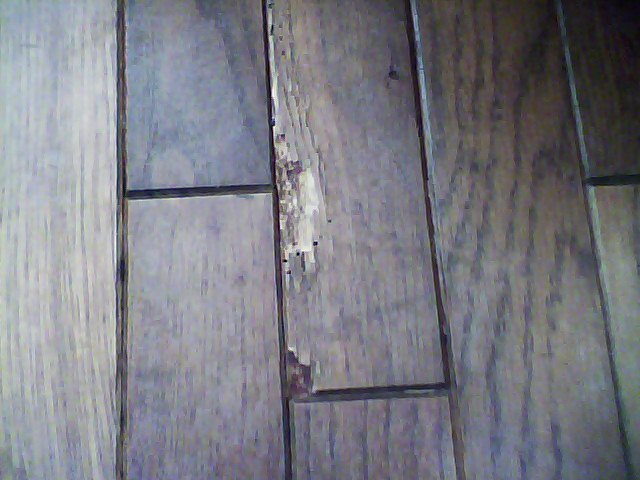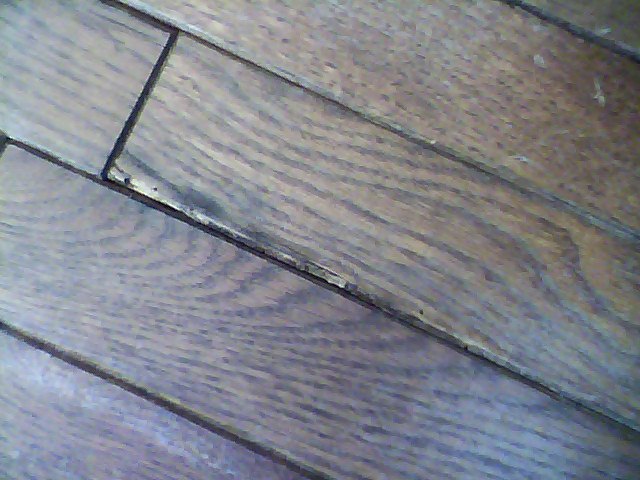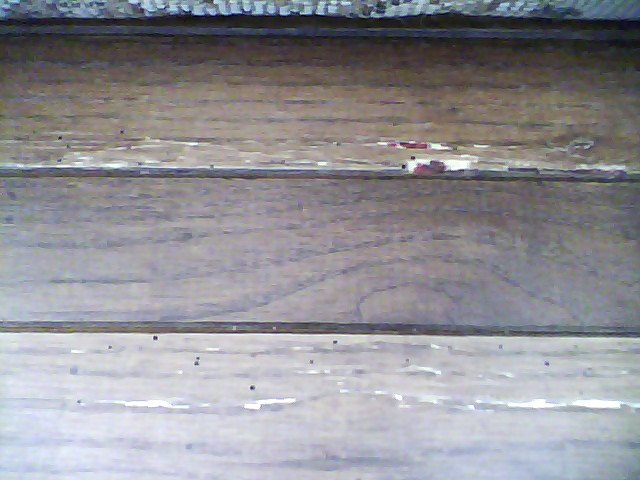Hi,
Have a cherry (I think) solid 1/2 inch high X 2 1/4 inch wide plank, hardwood floor on second level (above grade) of a 25 yo house,
which is probably the original one and was put in during house construction. The hardwood floor has visible signs of infestation
which are concentrated in few major areas, with numerous "exit holes" about 1/16 to 1/8 of an inch in diameter as well as chewed off wood (please see attached pictures).
"This is the largest visible infestation area (all others are much smaller than this)."

Hardwood floor (from one side) is adjacent to 2 patio doors that are also probably original (25 yo as well) and leaky. Any time
there is a significant rain / snow water leaks through the patio doors and needs to be wiped off from the hardwood floor, also
penetrating below the hardwood floor into the sub-floor as evidenced by the hardwood floor cupping in several places. Also,
lifting 2 registers very close to the patio doors (which allows seeing the inside of the floor) shows the bottom of hardwood floor
having visible water damage.
"Cupping and infestation"

The problem has deteriorated slowly over the last 9 years, so I am pretty sure these are not termites (as otherwise the entire
house would have probably collapsed by now), but rather some wood bug / beetle of some sort. Local fumigation was done last year, which was not effective as the number of "exit holes" and chewed off areas has increased since then.
Infestation under the carpet

The hardwood floor and the 2 patio doors are old and need replacement anyways. Having done research online I think
that I'll go with either classic or wood (top 1/6 of an inch is real wood, everything below is high temperature wood composite)
laminate as replacement and not solid hardwood, specifically given the infestation history and the fact that laminate flooring
is specifically engineered against infestation to prevent re-infestation (just in case some eggs still remain in the house after
the removal of the hardwood floors).
I have few questions pertaining to this that I would very much appreciate feedback on :
1. What kind of bug / beetle is this exactly ?
2. After I remove all of the currently infested hardwood floor :
a. should the entire (or some parts of it) sub floor be replaced ?
If yes, should I pre-treat the new sub floor with any special chemical, and which one I should use for this particular infestation ?
If not, (and assuming all or part of the sub floor are in decent shape without any water damage), is it sufficient to just treat
the sub floor with the chemical (and which one I should use for this particular infestation) to ensure that all eggs (if any) in it are dead ?
b. should I also treat all of the walls, trim, etc. with the same chemical ?
c. There is a stairwell completely covered with carpet, going to the third level with wooden hand-rails whose base and carpet are
sitting on the hardwood (very close to one of its infested areas). As far as I can say the wooden hand-rails have not been infested
with this. Should the wooden hand-rails and carpet be treated with a chemical ? If yes, which one ? Should the carpet be replaced
and sub floor below it treated with the chemical to ensure that all eggs (if any) in it are dead ?
d. There is other wooden furniture in the room (sofas, table, tv stand, dining table and chairs, etc.) which as far as I can say
have not been infested with this. Should they also be treated ? If yes, with what chemical ?
3. Any specific recommendations on the type of classic or wood laminate to install to prevent the re-infestation ?
4. Before I install the new classic or wood laminate (instead of the old infested hardwood) should I pre-treat it with any
chemical to prevent re-infestation ? If yes, which one ?
5. After I remove 2 patio doors, should I treat the door jambs, any visible insulation, etc. with any chemical ? If yes, which one.
6. The 2 new patio doors I'd like to install have aluminum clad on the outside and wood (probably pine) on the inside (which is untreated, but the manufacturer includes a kit for treating and finishing it). Is there any additional chemical that I have to pre-treat the door with to prevent re-infestation ? If yes, which one ?
Thank you very much.




